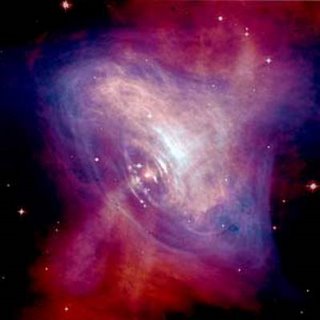Strings in the Universe

_________________________________________
Credits for X-ray Image: NASA/CXC/ASU/J. Hester et al.
Weber's Oscillations
In the late 1950s, Weber became intrigued by the relationship between gravitational theory and laboratory experiments. His book, General Relativity and Gravitational Radiation, was published in 1961, and his paper describing how to build a gravitational wave detector first appeared in 1969. Weber's first detector consisted of a freely suspended aluminium cylinder weighing a few tonnes. In the late 1960s and early 1970s, Weber announced that he had recorded simultaneous oscillations in detectors 1000 km apart, waves he believed originated from an astrophysical event. Many physicists were sceptical about the results, but these early experiments initiated research into gravitational waves that is still ongoing. Current gravitational wave experiments, such as the Laser Interferometer Gravitational Wave Observatory (LIGO) and Laser Interferometer Space Antenna (LISA), are descendants of Weber's original work.
______________________
Renaud Parentani's high frequencies
The study of acoustic black holes has been undertaken to provide new insights about the role of high frequencies in black hole evaporation. Because of the infinite gravitational redshift from the event horizon, Hawking quanta emerge from configurations which possessed ultra high (trans-Planckian) frequencies. Therefore Hawking radiation cannot be derived within the framework of a low energy effective theory; and in all derivations there are some assumptions concerning Planck scale physics. The analogy with condensed matter physics was thus introduced to see if the asymptotic properties of the Hawking phonons emitted by an acoustic black hole, namely stationarity and thermality, are sensitive to the high frequency physics which stems from the granular character of matter and which is governed by a non-linear dispersion relation. In 1995 Unruh showed that they are not sensitive in this respect, in spite of the fact that phonon propagation near the (acoustic) horizon drastically differs from that of photons. In 2000 the same analogy was used to establish the robustness of the spectrum of primordial density fluctuations in inflationary models. This analogy is currently stimulating research for experimenting Hawking radiation. Finally it could also be a useful guide for going beyond the semi-classical description of black hole evaporation.
__________________________
Strominger:
Boltzmann had one–the theory of molecules. We needed a microscopic theory for black holes that had to have three characteristics: One, it had to include quantum mechanics. Two, it obviously had to include gravity, because black holes are the quintessential gravitational objects. And three, it had to be a theory in which we would be able to do the hard computations of strong interactions. I say strong interactions because the forces inside a black hole are large, and whenever you have a system in which forces are large it becomes hard to do a calculation.
_________________________
String Theory
String theory grew out of attempts to find a simple and elegant way to account for the diversity of particles and forces observed in our universe. The starting point was to assume that there might be a way to account for that diversity in terms of a single fundamental physical entity (string) that can exist in many "vibrational" states. The various allowed vibrational states of string could theoretically account for all the observed particles and forces. Unfortunately, there are many potential string theories and no simple way of finding the one that accounts for the way things are in our universe.
One way to make progress is to assume that our universe arose through a process involving an initial hyperspace with supersymmetry that, upon cooling, underwent a unique process of symmetry breaking. The symmetry breaking process resulted in conventional 4 dimensional extended space-time AND some combination of additional compact dimensions.
_______________________________________________________
Quote of the Day:
We have, I fear, confused power with greatness.
Stewart L. Udall
_______________________________________________________
For further reading please visit:
grand quantum conjecture by Plato
bumblebee wing rotations and dancing by Plato
_______________________________________________________
_______________________________________________________
Labels: Strings, Theoretical Physics


<< Home